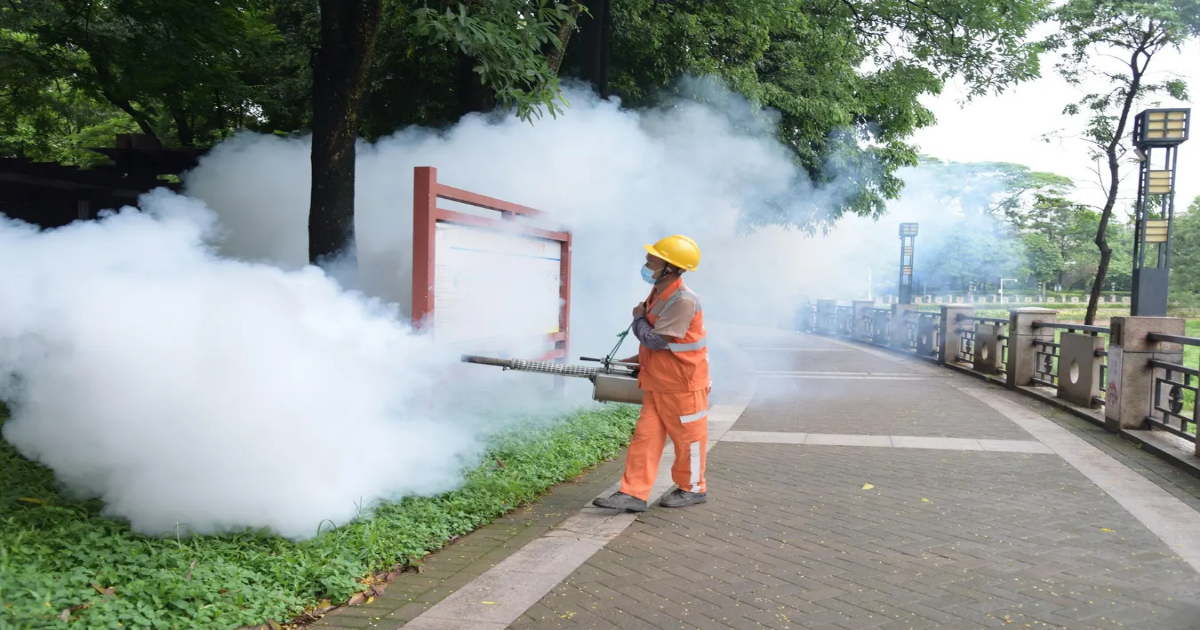A mosquito-born virus that has infected more than 7,000 people across at least 13 cities in China has sparked precautions similar to those imposed during the COVID pandemic in attempts to stop its spread despite the virus not being transmittable from person to person.
A sanitation worker sprays insecticide to prevent the spread of Chikungunya on Aug. 3, 2025 in Dongguan, Guangdong Province of China.
VCG via Getty Images
Key Facts
The chikungunya virus, which spreads only through the bite of an infected mosquito and is not usually fatal, has spread quickly across more than a dozen cities in the southern Guangdong province, just north of Hong Kong, with almost 3,000 cases reported in the last week alone, according to the BBC.
Chikungunya is usually a rarity in China but infections have spread rapidly after an imported case was detected in Foshan city, which has been the hardest hit, on July 8 and spread from there, the New York Times reported.
In Guangdong, measures reminiscent of those used during the COVID pandemic have been instituted, including requiring all infected patients to remain in hospital quarantine under a mosquito net until they test negative for the virus, according to a translation of Chinese news outlet NF News.
Authorities are conducting door-to-door home inspections to ensure the elimination of stagnant water, where mosquitos breed, and those who fail to cooperate can be fined or face criminal charges for “obstructing the prevention of infectious diseases,” according to a government flyer translated by the Times.
Other precautions taken include introducing giant “elephant mosquitoes” in the region in hopes their larvae will eat the virus-carrying mosquitoes, releasing mosquito-eating fish into local ponds, spraying pesticides and sending out drones with the mission of identifying mosquito breeding sites, the Times reported.
Get Forbes Breaking News Text Alerts: We’re launching text message alerts so you’ll always know the biggest stories shaping the day’s headlines. Text “Alerts” to (201) 335-0739 or sign up here: joinsubtext.com/forbes.
Surprising Fact
At least five households had their electricity cut off because they did not cooperate with door-to-door inspections, the New York Times reported, citing a neighborhood committee notice issued in the district of Guicheng.
What Is Chikungunya Virus?
Chikungunya is a mosquito-born virus that presents most commonly with a headache, muscle pain, nausea, fatigue, rash and swollen joints. While most symptoms usually resolve within two weeks, the “debilitating” joint pain can persist for months or years, according to the World Health Organization. The joint pain is the calling card of chikungunya and, without it, people with the virus can easily be misdiagnosed as having dengue or Zika, making it hard to know exactly how many people are infected. Chikungunya was first detected in southern Tanzania in the 1950s. The name comes from a word in the Kimakonde language of southern Tanzania that means “that which bends up,” meant to describe the contorted posture of people with severe joint pain.
How Does Chikungunya Virus Spread?
Chikungunya can only be transmitted to a person through the bite of an infected mosquito, but people can transmit it right back to the insect. So if a non-infected mosquito bites a person with the chikungunya, it can contract the virus and infect the next healthy person it bites. It is not contagious or transmittable person to person.
Is There A Chikungunya Vaccine?
Yes. There are two approved for use in the United States: IXCHIQ, a live-attenuated vaccine, is approved for people 18 and older and VIMKUNYA, a virus-like particle vaccine, is approved for those 12 and older. The CDC only recommends the vaccine to people traveling to an area with a chikungunya outbreak.
Is There Chikungunya Virus In The United States?
Yes, but it’s not common. In the U.S., chikungunya is primarily found in travelers who’ve been infected in other countries and a locally acquired case hasn’t been reported since 2019. But travel-associated cases are on the rise. Chikungunya was rarely found in the U.S. before 2006, but as many as 28 people per year tested positive from 2006 to 2013. Nearly 3,000 travel-associated cases were identified in 2014 but that number steadily decreased down to 36 in 2021 before slowly climbing again. There were 199 cases found in 2024 and, in 2025, there have been 46 cases so far.
Where Chikungunya Virus Most Commonly Found?
The Centers for Disease Control and Prevention warn that U.S. travelers visiting Brazil, Columbia, India, Mexico, Nigeria, Pakistan, Thailand and the Philippines are at an elevated risk of exposure. The CDC also issued a Level 2 travel alert for Foshan city, and recommends any traveler to the area be vaccinated. People who do visit are encouraged to prevent mosquito bites by wearing insect repellent, long-sleeved shirts and long pants. Pregnant women are advised not to travel to the region.
What To Watch For
More infections. Hong Kong reported its first case of chikungunya in a 12-year-old boy Monday.
Further Reading
ForbesChikungunya Gotcha Down? The Virus That Got Lindsay LohanBy Judy StoneForbesAre Mosquito-Borne Viruses Becoming More Common and Severe? A Clinical Virologist ExplainsBy Matthew BinnickerForbesFirst Chikungunya Vaccine Now FDA Approved — What To Know About The ‘Emerging Global Health Threat’By Robert Hart
